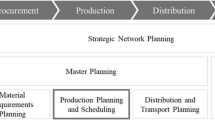Abstract
Delayed Product Differentiation (DPD) can reduce the manufacturing complexities arising due to the proliferation of products variety. A new optimization model constructs the optimum layout of delayed differentiation assembly lines for a mix of products to be manufactured by the same system and optimizes the position of the differentiation points. This model employs a classification tool (Cladistics) used in biological analysis and modifies it for use in planning DPD assembly lines configurations in order to incorporate the assembly precedence constraints, required production rates of different product variants and existing production capacity of work stations. The optimum layout configuration ensures that the quantities required of different products are produced on the same line; while achieving balance, minimizing duplication of stations and maximizing the overall system utilization. The developed model has been applied to a group of automobile engine accessories normally assembled on different lines. The use of Cladistics to analyze product variants that are candidates for delayed assembly is an original approach for designing the assembly line layout and identifying the best differentiation points. It also helps rationalize the design of product variants and their features to further delay their assembly differentiation and achieve economy of scale without affecting their functionality.












Similar content being viewed by others
References
AlGeddawy T, ElMaraghy H (2009) Assembly systems layout design model for delayed products differentiation. Int J Prod Res 48(18):5281–5305
Boysen N, Fliedner M, Scholl A (2007) A classification of assembly line balancing problems. Eur J Oper Res 183:674–693
Boysen N, Fliedner M, Scholl A (2009) Production planning of mixed-model assembly lines: Overview and extensions. Prod Plan Control Manage Operat 20(5):455–471
Bragg S (2004) Inventory best practices. Wiley, New Jersy
Cassidy RL, Fan SK, MacDonald RS, Samson WF (1979) Serpentine—extended life accessory drive. SAE Preprints (790699)
Caux C, David F, Pierreval H (2006) Implementation of delayed differentitation in batch process industries: a standardization problem. Int J Prod Res 44(16):3243–3255
Chen S, Kang H, Lee H (2006) Dynamic programming approach for analyzing delayed product differentiation. Int J Adv Manuf Technol 28(5–6):445–449
De Lit P, Delchambre A, Henrioud JM (2003) An integrated approach for product family and assembly system design. IEEE Trans Robotics Autom 19(2):324–334
ElMaraghy H, AlGeddawy T, Azab A (2008) Modelling evolution in manufacturing: a biological analogy. CIRP Ann Manuf Technol 57(1):467–472
Fournier X, Agard B (2007) Improvement of earliness and lateness by postponement on an automotive production line. Int J Flex Manuf Syst 19:107–121
Fujimoto H, Ahmed A, Iidda Y, Hanai M (2003) Assembly process design for managing manufacturing complexities because of product varieties. Int J Flex Manuf Syst 15:283–307
Garg A, Tang C (1997) On postponement strategies for product families with multiple points of differentiation. IIE Trans 29(8):641–650
Harrison A, Skipworth H (2008) Implications of form postponement to manufacturing: a cross case comparison. Int J Prod Res 46(1):173–195
Hennig W (1966) Phylogenetic systematics. University of Illinois Press, Urbana (republished in 1999)
Hsu H, Wang W (2004) Dynamic programming for delayed product differentiation. Eur J Prod Res 156(1):183–193
Kitching IJ, Forey PL, Humphries CJ, Williams DM (1998) Cladisitcs: the theory and practice of parsimony analysis, second edition. Oxford University Press, the Systematics Association, Oxford
Klampfl E, Gusikhin O, Rossi G (2005) Optimization of workcell layouts in a mixed-model assembly line environment. Int J Flex Manuf Sys 17:277–299
Ko J, Jack Hu S (2008) Balancing of manufacturing systems with complex configurations for delayed product differentiation. Int J Prod Res 46(15):4285–4308
Lee H, Billington C (1994) Designing products and processes for postponement. In: Dasu S, Eastman C (eds) Management of design: engineering, management perspectives. Kluwer Academic Publishers, Boston
Lee HF, Johnson RV (1991) A line-balancing strategy for designing flexible assembly systems. Int J Flex Manuf Syst 3:91–120
Lee L, Tang C (1997) Modelling the costs and benefits of delayed product differentiation. Manage Sci 43(1):40–53
Miltenburg J (2002) Balancing and scheduling mixed-model u-shaped production lines. Int J Flex Manuf Syst 14:123–155
Rekiek B, Delchambre A (2006) Assembly line design: the balancing of mixed-model hybrid assembly lines with genetic algorithms. Springer, London
Rekiek B, De Lit P, Delchambre A (2000) Designing mixed-product assembly lines. Robotics Autom IEEE Trans 16(3):268–280
Shao X, Ji J (2008) Evaluation of postponement strategies in mass customization with service guarantees. Int J Prod Res 46(1):153–171
Swaminathan J, Lee L (2003) Chapter 5: design for postponement. In: De-Kok A, Graves S (eds) Supply chain management: design, coordination and operation. Elsevier, North-Holland, pp 199–226
Swaminathan J, Tayur S (1998) Managing broader product lines through delayed differentiation using vanilla boxes. Manage Sci 44(12-part 2 of 2):161–172
Swaminathan J, Tayur S (1999) Managing design of assembly sequences for product lines that delay product differentiation. IIE Trans 31(11):1015–1026
Ulrich K, Tung K (1991) Fundamentals of product modularity. ASME Issues Des/Manuf Integr 39(1):73–79
Ulsoy AG, Whitesell JE, Hooven MD (1985) Design of belt-tensioner systems for dynamic stability. ASME J Vibr Acoust Stress Reliab Des 107(3):282–290
Author information
Authors and Affiliations
Corresponding author
Rights and permissions
About this article
Cite this article
AlGeddawy, T., ElMaraghy, H. Design of single assembly line for the delayed differentiation of product variants. Flex Serv Manuf J 22, 163–182 (2010). https://doi.org/10.1007/s10696-011-9074-7
Published:
Issue Date:
DOI: https://doi.org/10.1007/s10696-011-9074-7




